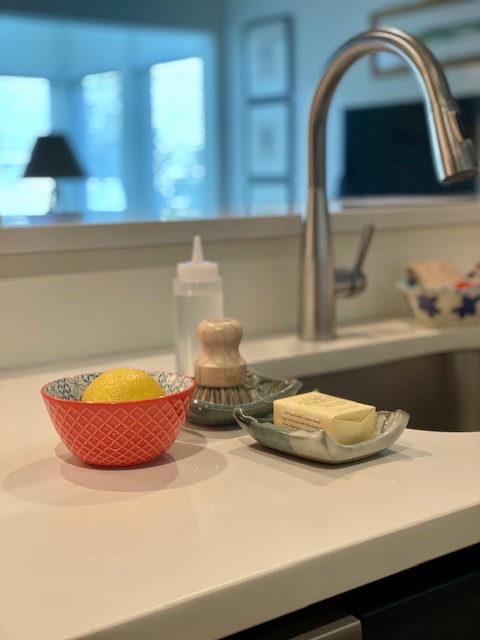✨Now that we are grandparents, our home is not set up with day-to-day activities for our young grandchildren. However, when our grandchildren visit, we have age-appropriate toys, games, puzzles and books organized for them in a few of our home cabinets. We also have Montessori-at-home practical life materials ready to use as learning tools. These materials include everyday kitchen items such as wooden toast tongs, condiment squeeze bottles, fresh fruit juicers, scrub brushes, vegetable peelers, cutting boards, and more.
Prepare for Practical Life Learning
With a little thought and preparation, it’s really not difficult to create activities for the 2- to 6-year-old child. During their formative years, activities that relate to our daily work in the home, i.e. cooking, cleaning, care for animals and plants, etc., are very familiar to the young child; they have been observing and absorbing these activities in their environment since birth, just waiting for their turn to try … And, when offered, an invitation to participate is almost always met with enthusiasm and makes the child feel valued.
As an example, below is a simple Lemon Scrubbing activity:
Select child-size and attractive materials (see below) found at home. These can be prepared on a small tray for the child to carry to the sink/work area. The child may need adult support when placing it up on the counter.
🍋One lemon in a bowl
🪥Scrubber (brush, pad or sponge) on a small plate
🧼Child-size bar of soap on a soap dish
🧴Supple squeeze bottle (filled with water)
🧺Soft cloth for spills and/or hand drying
First, invite the child, e.g., “Oh, I could really use some help in the kitchen! Would you like to join me and scrub a lemon?” Once they have accepted the invitation, show them the prepared tray to carry or items ready at the sink.
Next, ask the child, “Would you please bring our portable step stool to the sink? It will make the sink area easier for you to reach and more comfortable as you work.”
SHOW (Slow Hands Omit Words)
To begin, ask the child to, “Please watch with your eyes as I take a turn …” 👀
With two hands, slowly lift the bowl with the lemon and gently place it into the sink while listening for its quiet touch.
Next, using the water-filled bottle, gently (and with exaggerated movements) squeeze water onto the lemon in the bowl.
Lifting the scrub brush in one hand and the lemon in the other, slowly begin scrubbing.
Finally, place the lemon back in the bowl and invite the child to take a turn.
Repeat as long as the child is engaged. Then, show the child how to dry and return materials to the tray.
Activity Extensions
In addition to the scrubbing activity, invite the child to wash and dry their hands before and/or after the lesson, again showing how to do so first if needed. If the soap is new and wrapped, demonstrate how to remove and discard its paper as well. Also, once empty, show the child how to fill the water bottle.
The length and complexity of the activity is determined by the child’s interest and abilities. Depending on their age and interest, activity extensions can follow. Ask the child, “How might we use the lemon once it’s clean?”… The child may choose to slice it with a child-safe knife and add it to water or cut it in half and squeeze it into a juicer to make lemon juice for a pie or other recipe. Language, math, sensorial and cultural lessons can be added too. It’s good to be creative!
Practical Life Activities Lead to Connections
Regardless of the activity, practical life work can lead to all kinds of connections, learning and memory making for everyone. Along with building confidence, the child is developing their concentration, sequencing skills and strengthening their small and large motor control. Most of all, and it’s true, when grandparents share practical life lessons they create rich and lasting relationships with their grandchild too! ✨

